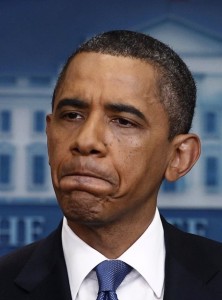October 24th, 2011 by Amy Bolger
 In an interview with “60 Minutes” that aired Sunday evening, Steve Jobs’ biographer Walter Isaacson revealed that the Apple founder had actually met his biological father face-to-face once – even though neither man had known at the time. The extremely private Jobs sought out his biological mother and sister in the mid 1980s, saying that he felt something was missing from his life. He became very close with his biological sister, novelist Mona Simpson. But, after learning a bit about his father, Abdulfattah Jandali, who had left his mother when Mona was still young, he decided against it. “I learned a little bit about him, and I didn’t like what I learned,” Jobs says in new audio recordings released by Isaacson. “I asked her to not tell him that we’d ever met and not tell him anything about me.” But, as it turns out they had already met, even though neither man realized it. When Mona Simpson tracked down Jandali, he told her about a restaurant he used to manage in Silicon Valley that was very popular. “Everybody used to come there… even Steve Jobs used to come there,” he told her. “He was a great tipper.” Simpson was shocked, but didn’t reveal that Jobs was Jandali’s son. “I remember meeting the owner who was from Syria, and it was most certainly him, and I shook his hand and he shook my hand and that’s all,” Jobs told Isaacson. Jandali, now 80, said he sent Jobs’ birthday emails after he found out he was his father, and claims that one time he received a response that just said “Thank you.” In an interview with “60 Minutes” that aired Sunday evening, Steve Jobs’ biographer Walter Isaacson revealed that the Apple founder had actually met his biological father face-to-face once – even though neither man had known at the time. The extremely private Jobs sought out his biological mother and sister in the mid 1980s, saying that he felt something was missing from his life. He became very close with his biological sister, novelist Mona Simpson. But, after learning a bit about his father, Abdulfattah Jandali, who had left his mother when Mona was still young, he decided against it. “I learned a little bit about him, and I didn’t like what I learned,” Jobs says in new audio recordings released by Isaacson. “I asked her to not tell him that we’d ever met and not tell him anything about me.” But, as it turns out they had already met, even though neither man realized it. When Mona Simpson tracked down Jandali, he told her about a restaurant he used to manage in Silicon Valley that was very popular. “Everybody used to come there… even Steve Jobs used to come there,” he told her. “He was a great tipper.” Simpson was shocked, but didn’t reveal that Jobs was Jandali’s son. “I remember meeting the owner who was from Syria, and it was most certainly him, and I shook his hand and he shook my hand and that’s all,” Jobs told Isaacson. Jandali, now 80, said he sent Jobs’ birthday emails after he found out he was his father, and claims that one time he received a response that just said “Thank you.”

October 4th, 2011 by Amy Bolger
 Amanda Knox is on her way home to Seattle, one day after an Italian appeals court overturned her controversial murder conviction, ending her four year nightmare. Amanda, 24, was seen at Leonardo da Vinci airport in Rome early Tuesday morning, along with several family members. Amanda Knox is on her way home to Seattle, one day after an Italian appeals court overturned her controversial murder conviction, ending her four year nightmare. Amanda, 24, was seen at Leonardo da Vinci airport in Rome early Tuesday morning, along with several family members.
Her father Kurt Knox and mother Edda Mellas declined to talk to reporters as they were escorted through the airport by plainclothes Italian police officers. They were accompanied by their spouses and children, but Amanda herself was spared the public check-in process and met up with her family on the flight. Amanda’s flight will make a stop in London; she’ll then catch a connecting flight to Seattle. She’s expected to arrive home in Washington state later on Tuesday.
Prior to leaving Italy, Amanda thanked those “who shared my suffering and helped me survive with hope,” in a letter to the Italy-US Foundation, which seeks to promote ties between Italy and the United States and championed Knox’s cause. “Those who wrote, those who defended me, those who were close, those who prayed for me,” Knox wrote. “I love you, Amanda.”
After ten hours of deliberations, the appeals jury on Monday reserved her conviction for the murder of her British roommate Meredith Kercher; the court also threw out the conviction of Knox’s former boyfriend Raffaele Sollecito. A third defendant, Rudy Guede, 24, was also convicted of Kercher’s murder in a separate trial and was sentenced to 30 years in prison. He had asked for his trial to be fast tracked, and later appealed with the conviction being upheld, but his sentence was shortened to 16 years.
Prosecutors in Italy say that they plan to appeal the jury’s decision, but legal experts say it’s not likely Amanda would be extradited back to the country to face a retrial.

September 14th, 2011 by Amy Bolger
 In a scene that was eerily reminiscent of Black Friday, Target’s website crashed several times throughout the day yesterday and more than hundred shoppers lined up at many of its stores early in the morning on Tuesday for a sale of limited offerings of its Missoni for Target collection of bikes, luggage, clothes and housewares. The 400-piece line made by the Italian luxury knitwear designer Missoni exclusively for the “cheap chic” retailer features its trademark zig-zag patterns for between $2.99 for stationary and $599.99 for patio furniture (a fraction of the price of the designer’s real duds that can cost $595 to $1,500). In a scene that was eerily reminiscent of Black Friday, Target’s website crashed several times throughout the day yesterday and more than hundred shoppers lined up at many of its stores early in the morning on Tuesday for a sale of limited offerings of its Missoni for Target collection of bikes, luggage, clothes and housewares. The 400-piece line made by the Italian luxury knitwear designer Missoni exclusively for the “cheap chic” retailer features its trademark zig-zag patterns for between $2.99 for stationary and $599.99 for patio furniture (a fraction of the price of the designer’s real duds that can cost $595 to $1,500).
So-called limited partnerships, in which high-end designers create cheaper versions of their fashions for lower-end stores, have become popular in recent years because they appeal to cost-conscious customers who want to be stylish but aren’t willing to pay designer prices. At a time when Americans are watching every dollar they spend, the limited-time offerings are also part of a growing strategy by retailers to spur impulse buys by creating a sense of urgency for shoppers to buy.
Swedish retailer H&M, which caters to 20- and 30-somethings with trendy clothes, often attracts long lines at its stores that reach around the block when it offers limited-run affordable collaborations from upscale designers like Jimmy Choo. It also will be launching a less expensive version of the Italian designer Versace’s fashion collection in November.
Target, in particular, has become known for creating a lot of buzz for its limited partnerships with designers and fashion brands, including its latest success with Liberty of London last year. Target offered 300 items with the designer, which is known for its floral prints, and sold out of most of the merchandise in a couple of days. Likewise, Target Corp., based in Minneapolis, worked hard to create buzz around the Missoni by Target collection. Target declined to comment on how much the company spent on marketing, but it targeted social media sites like Twitter and had ads on TV and in Vogue magazine. Obviously, their marketing campaign worked and was worth every penny they spent.

September 1st, 2011 by Amy Bolger
 Money doesn’t grow on trees… or does it? In this case, no, but it sprouted up in the garden. An unemployed man in northern Illinois was out working in his backyard when he came across some serious green: bags filled with $150,000 cash. Wayne Sabaj was out picking broccoli to go with his dinner roast when he spotted duffel bags that looked like trash by the peppers. When he opened the bags, they turned out to contain cash. There were stacks of $20 bills that added up to about $150,000. The 49-year-old, who is living with his dad, did not exactly jump for joy. The out-of-work carpenter told ABC7, “I could really use this money.” But with this money comes trouble. He explained, “With my luck, it would be bank robbery and I’d get caught and say I’d robbed a bank.” So the honest man with money troubles alerted the police to his amazing backyard treasure. For now, police haven’t a clue to where the cash came from. There have been no reported burglaries in the area, and no banks have been robbed. Then there was the concern that whoever left the money behind would be back, and that’s a problem Sabaj would rather have dealt with by the police. If nobody comes forward to legitimately claim the cash, there may be a happy ending for the man tending his garden: Police will return the money to Sabaj. The carpenter has retained an attorney just in case. For now, the cash is in custody with the country sheriff, who left behind a card on the lawn where Sabaj found the bags, bearing the simple message, “Please Call”. Money doesn’t grow on trees… or does it? In this case, no, but it sprouted up in the garden. An unemployed man in northern Illinois was out working in his backyard when he came across some serious green: bags filled with $150,000 cash. Wayne Sabaj was out picking broccoli to go with his dinner roast when he spotted duffel bags that looked like trash by the peppers. When he opened the bags, they turned out to contain cash. There were stacks of $20 bills that added up to about $150,000. The 49-year-old, who is living with his dad, did not exactly jump for joy. The out-of-work carpenter told ABC7, “I could really use this money.” But with this money comes trouble. He explained, “With my luck, it would be bank robbery and I’d get caught and say I’d robbed a bank.” So the honest man with money troubles alerted the police to his amazing backyard treasure. For now, police haven’t a clue to where the cash came from. There have been no reported burglaries in the area, and no banks have been robbed. Then there was the concern that whoever left the money behind would be back, and that’s a problem Sabaj would rather have dealt with by the police. If nobody comes forward to legitimately claim the cash, there may be a happy ending for the man tending his garden: Police will return the money to Sabaj. The carpenter has retained an attorney just in case. For now, the cash is in custody with the country sheriff, who left behind a card on the lawn where Sabaj found the bags, bearing the simple message, “Please Call”.

July 25th, 2011 by Amy Bolger
 The question always arises after any drug-related celebrity death about whether the star was surrounded by enablers who ignored health risks to keep their meal ticket in motion. Ahem, Howard K. Stern. But we may never have seen a celebrity case as extreme as Winehouse’s: The last four to five years of her life represented as extended and public a trainwreck as pop culture has ever witnessed. This was not a Heath Ledger, whose problems were kept largely under wraps, tipped only by suspiciously heavy-lidded interviews, but a superstar who seemed to openly flaunt her drug use, regardless of people shaming her. The question always arises after any drug-related celebrity death about whether the star was surrounded by enablers who ignored health risks to keep their meal ticket in motion. Ahem, Howard K. Stern. But we may never have seen a celebrity case as extreme as Winehouse’s: The last four to five years of her life represented as extended and public a trainwreck as pop culture has ever witnessed. This was not a Heath Ledger, whose problems were kept largely under wraps, tipped only by suspiciously heavy-lidded interviews, but a superstar who seemed to openly flaunt her drug use, regardless of people shaming her.
“I realize my daughter could be dead within the year,” said her mother, Janis. “We’re watching her kill herself, slowly. I’ve already come to terms with her dead. I’ve steeled myself to ask her what ground she wants to be buried in, which cemetery. Because the drugs will get her if she stays on this road. I look at Heath Ledger… She’s on (his) path. It’s like watching a car crash — this person throwing all these gifts away.” The year of this interview? 2008.
“Perhaps it is time to stop buying records,” said her former father-in-law, Giles Fielder-Civil, suggesting a boycott as a last resort. “It’s a possibility, to send that message… It’s about time that their friends and their professional colleagues say to them ‘enough is enough’.” This was all the way back in the summer of 2007. All the writing was on the wall before she became popular in the states.
Her father-in-law thought a boycott could force Winehouse’s label to reign her in. But Winehouse’s equally concerned father, Mitch, called in to the same program to say the record company was doing everything it could. “There’s only one person to blame and that’s Amy,” her father declared four years ago. “That’s what Blake’s parents have got to understand… There’s no question of the record company or her family trying to work her to the bone. These are some of the accusations that have been levelled at us.” In contrast to the popular conception of corporate enablers, Mitch Winehouse described “caring, loving people from the record company, people who have been in the business for 20 or 30 years who are used to seeing matters like this, crying their eyes out because of their genuine love and affection for Amy. The record company isn’t as callous as some people think it is.”
Given the widespread awareness and acceptance of her problems, surely she could have been saved if she entered rehab, right? Except that this was the woman who famously said “no, no, no” to rehab.
The first time she went into rehab, by her own ridiculous account, was before she recorded the 2007 hit “Rehab” and helped inspire the nay-saying song. “I did [go to rehab], for just 15 minutes,'” she told the Sun. “I went in and said ‘Hello’ and explained that I drink because I’m in love and have [messed] up the relationship. Then I walked out.”
Winehouse’s parents and representatives of her management set up an intervention meeting after things started deteriorating so publicly in 2007, but Winehouse and her husband skipped it to meet his in-laws at the pub. But her troubles soon caught the attention of the law. In Norway, the couple was arrested for drug possession and let off with a fine. In December, she was busted in London for interfering with a case against Blake, who was soon to spend two years in jail on an assault charge. In January 2008, Scotland Yard looked into, but ultimately didn’t act on, a world viewed video that showed Winehouse appearing to smoke crack.
When the infamous crack video emerged, Mitch Winehouse said he wanted to get her sectioned under England’s Mental Health Act to force her to clean up, but couldn’t. “You might consider taking drugs is a danger to herself, but unfortunately the authorities don’t,” he said. As for her attitude, “Part of the problem is she doesn’t think she’s got a problem. She thinks she can do what she does recreationally and get on with the rest of her life.”
But, following the bad PR, she did check herself into rehab on January 24, 2008. Again, she didn’t stay long, and emerged in time to perform via satellite on the Grammy Awards, where she swept the top prizes. It was the kind of massive validation that some observers thought might shore up her ego and render intoxication unnecessary. But that assumption hardly took into account the scope of her addiction.
The years 2009-10 brought a bevy of further incidents: an alleged assault against a theater manager who’d asked her to change seats at a performance of “Cinderella”; punching out an innocent fan at a gig, whom she mistook for someone who’d thrown an object at her; messing up the lyrics to “Valerie” at a rare, brief public performance with producer Mark Ronson; and an official end to her literally combative relationship with her husband, though, not surprisingly, she got back together with him for a time after the divorce.
In early 2011, Mitch Winehouse said that his daughter had been clean for about “two and a half years,” while cautioning that “I’m not saying her problems have gone away.” This provided great reason for optimism, as the father had not been one to sugar-coat her problems in the past. A European tour was booked during this supposedly healthy time.
But things took another turn for the worse, leading her to make her final entry into rehab on May 27. As she checked into the Priory Clinic again, an official statement cited her desire to “seek an assessment” and “be ready for performances in Europe this summer.” We all saw the youtube video in Belgrade though. The Daily Mail reported the claim that shortly before her death Winehouse purchased “a cocktail of narcotics” that included cocaine and ecstasy, though the authorities in London have cautioned against a leap to judgment about any overdose before autopsy reports come in.
Surely there were enablers on the lower, non-public rungs of Winehouse’s entourage: the dealers and ever-present hangers-on in and around her North London flat. But when it comes to her family and professional reps, there’s little reason to imagine there was anything in Winehouse’s five-year-long incapacitation for them. Her father likely had it right in 2007 when he said there was one person to blame: Amy.

July 19th, 2011 by Amy Bolger
 On Monday, Republican Sen. Mike Enzi of Wyoming introduced legislation to fix a glitch that would have allowed some middle-class early retirees to get health insurance at virtually no cost by qualifying for Medicaid coverage meant for the poor. Democratic Sen. Ben Nelson of Nebraska introduced a similar bill, signaling the fix could have bipartisan support. On Monday, Republican Sen. Mike Enzi of Wyoming introduced legislation to fix a glitch that would have allowed some middle-class early retirees to get health insurance at virtually no cost by qualifying for Medicaid coverage meant for the poor. Democratic Sen. Ben Nelson of Nebraska introduced a similar bill, signaling the fix could have bipartisan support.
The problem surfaced very recently. The mix-up would have created unintended consequences for tax credits that Obama’s law provides to make private health insurance more affordable for people who purchase coverage individually. An early retiree drawing Social Security would have paid much less for the same policy than someone of the same age, similar medical history, earning the same total income from work. Tax credits and a Medicaid expansion are part of the law’s big push to cover the uninsured, which starts in 2014.
Health and Human Services spokeswoman Erin Shields welcomed Enzi’s involvement. “We look forward to studying his proposal,” she said. “The administration is exploring options for a fix.”
The Associated Press first reported the problem last month, after Medicare Chief Actuary Richard Foster raised concerns and said he was having trouble getting policymakers interested. The nonpartisan actuary’s office conducts long-range cost estimates for government health care programs. “I try to stay out of policy issues, but this is one where I think a change is in order,” Foster told the House Budget Committee last week. Earlier, he simply said the glitch “just doesn’t make sense.”
Enzi’s legislation would reverse the health care law, requiring Social Security income to be counted as income when determining eligibility for Medicaid and for tax credits to purchase private insurance. In a memo provided by the senator’s office, the nonpartisan Congressional Budget Office estimated the legislation would reduce the deficit by about $13 billion between 2014 and 2021, without raising the number of uninsured people.
“The change in the income definition is estimated to have a negligible effect on the number of individuals who are uninsured,” said the CBO memo. People would still be able to get coverage, they just wouldn’t be getting it free or as heavily discounted. The fix would affect about 500,000 to 1 million people a year, a smaller number than the 3 million Foster’s office had estimated.

July 13th, 2011 by Amy Bolger
 Netflix is going to raise the monthly prices of their plan that lets subscribers watch unlimited movies and video on demand and get DVDs by mail by 60%. Customers who want both services will pay $7.99 per month to rent one DVD at a time plus $7.99 for unlimited streaming, or a total of $15.98 per month. The previous cost of this plan was $9.99 a month. Netflix is going to raise the monthly prices of their plan that lets subscribers watch unlimited movies and video on demand and get DVDs by mail by 60%. Customers who want both services will pay $7.99 per month to rent one DVD at a time plus $7.99 for unlimited streaming, or a total of $15.98 per month. The previous cost of this plan was $9.99 a month.
“We are separating unlimited DVDs by mail and unlimited streaming into separate plans to better reflect the costs of each and to give our members a choice: a streaming only plan, a DVD only plan or the option to subscribe to both,” Netflix Vice President of Marketing Jessie Becker wrote in a company blog post.
“Given the long life we think DVDs by mail will have, treating DVDs as a $2 add on to our unlimited streaming plan neither makes great financial sense nor satisfies people who just want DVDs,” Becker wrote.
Netflix announced the new prices on Tuesday. The company did not respond to a request for comment.
Unlimited DVD-only plans will cost $7.99 for one at a time or $9.99 for two at a time. The changes take effect immediately for new subscribers, and in September for current customers.

|
|
 In an interview with “60 Minutes” that aired Sunday evening, Steve Jobs’ biographer Walter Isaacson revealed that the Apple founder had actually met his biological father face-to-face once – even though neither man had known at the time. The extremely private Jobs sought out his biological mother and sister in the mid 1980s, saying that he felt something was missing from his life. He became very close with his biological sister, novelist Mona Simpson. But, after learning a bit about his father, Abdulfattah Jandali, who had left his mother when Mona was still young, he decided against it. “I learned a little bit about him, and I didn’t like what I learned,” Jobs says in new audio recordings released by Isaacson. “I asked her to not tell him that we’d ever met and not tell him anything about me.” But, as it turns out they had already met, even though neither man realized it. When Mona Simpson tracked down Jandali, he told her about a restaurant he used to manage in Silicon Valley that was very popular. “Everybody used to come there… even Steve Jobs used to come there,” he told her. “He was a great tipper.” Simpson was shocked, but didn’t reveal that Jobs was Jandali’s son. “I remember meeting the owner who was from Syria, and it was most certainly him, and I shook his hand and he shook my hand and that’s all,” Jobs told Isaacson. Jandali, now 80, said he sent Jobs’ birthday emails after he found out he was his father, and claims that one time he received a response that just said “Thank you.”
In an interview with “60 Minutes” that aired Sunday evening, Steve Jobs’ biographer Walter Isaacson revealed that the Apple founder had actually met his biological father face-to-face once – even though neither man had known at the time. The extremely private Jobs sought out his biological mother and sister in the mid 1980s, saying that he felt something was missing from his life. He became very close with his biological sister, novelist Mona Simpson. But, after learning a bit about his father, Abdulfattah Jandali, who had left his mother when Mona was still young, he decided against it. “I learned a little bit about him, and I didn’t like what I learned,” Jobs says in new audio recordings released by Isaacson. “I asked her to not tell him that we’d ever met and not tell him anything about me.” But, as it turns out they had already met, even though neither man realized it. When Mona Simpson tracked down Jandali, he told her about a restaurant he used to manage in Silicon Valley that was very popular. “Everybody used to come there… even Steve Jobs used to come there,” he told her. “He was a great tipper.” Simpson was shocked, but didn’t reveal that Jobs was Jandali’s son. “I remember meeting the owner who was from Syria, and it was most certainly him, and I shook his hand and he shook my hand and that’s all,” Jobs told Isaacson. Jandali, now 80, said he sent Jobs’ birthday emails after he found out he was his father, and claims that one time he received a response that just said “Thank you.”




